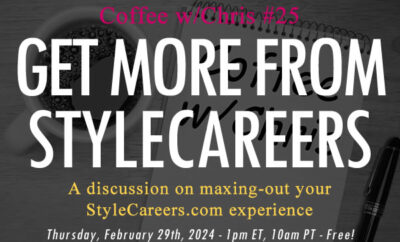
Portfolios
5 Portfolio Tips for Fashion Freelancers
Your fashion portfolio can make or break your chances of landing your next dream freelance client. If you want to create a professional, standout portfolio to kickstart or grow your freelance career, there are some best practices to follow.
Here are my top 5 tips based on my 10+ year career as a true remote fashion freelancer.
1. Only show relevant word
Of the 100s of portfolios I’ve seen over the years, one of the biggest mistakes designers make is cramming too much stuff in there. Whether you’ve got a decade of experience or are a new grad, this is the #1 problem with most portfolios.
As a freelancer, you shouldn’t offer every service in every category (even if you’re capable). You’ll find more clients, make more money, and make your life much easier if you choose a niche. Whether it’s design through development for lingerie brands or tech packs for active and swim, your offering should be focused.
Which means your portfolio should also be focused. You only need 3-5 projects that speak to the brands you’re pitching to. Unsure what to include? Follow my Portfolio Golden Rule to decide what to keep and what to leave out:
“This [project / collection / design] speaks to the brand, tells them that I understand their market, customer and aesthetic, and visually shows them that I am the right designer for the job.”
If it doesn’t pass the PGR, leave it out. Because when it comes to your portfolio, less is more.
2. Show your process
Brands want to see the evolution of your work, not just the finished product. Which is why you want to create what I call the Process Portfolio. Whether you’re a designer, product developer or TD, there is a process to your work. Show this in your portfolio!
What exactly does that include? Let’s look at two examples – design and technical.
The Process Portfolio for designers:
- Ideation: moodboard + hand sketches / doodles (if you do them, if not a moodboard collage is sufficient)
- Digital fashion flats in Adobe Illustrator (for most brands, hand sketches are not enough – they want to see that you know AI)
- Tech pack / tech sketches (a couple screenshots is sufficient to show your understanding)
- Photos of the finished product (if you have them, if not, that’s ok)
The Process Portfolio for Technical Designers / Product Developers:
- Tech pack / tech sketches (a couple screenshots is sufficient to show your understanding)
- Photos of marked up samples with proto comments
- Photos of fittings to show before / after
You don’t have to include everything depending on what services you’re offering, but think about your process and showcase that. It may only be 2 or 3 steps, but letting a brand see different stages of your work will highlight your skills and help you stand out.
3. Be critical with school projects
Most school projects that I’ve seen in portfolios shouldn’t be there. They’re often irrelevant, too theoretical, and just don’t match the real life skills brands need. Use the Portfolio Golden Rule again to decide whether they belong or not:
“This [project / collection / design] speaks to the brand, tells them that I understand their market, customer and aesthetic, and visually shows them that I am the right designer for the job.”
If you’ve got some design + flats + tech packs from school that do showcase your work, then leave them in there. But most of the time it’s best to omit the pics of your senior collection and photos of draping on a mannequin. 99% of these photos look amatuer and aren’t what brands are interested in.
While it’s ok to include school (or self-directed) projects, be mindful that they showcase your services and aren’t in there as filler (or just because you’re proud).
4. Don’t worry about the platform
One of the most common portfolio questions is, “what platform should I use?” It’s easy to get overwhelmed with all the choices…
- StylePortfolios
- Wix
- Behance
- Coroflot
- Carbonmade
- Adobe Portfolio
- Squarespace
- WordPress
- And more that I probably haven’t even heard of…
It’s less about the platform and more about what you do (and don’t) include. My best advice? Create a 3-5 page PDF and call it a day. Include a Dropbox link in your pitch and you’re done. As a freelancer, you don’t need a full fledged website (yet). As you grow, it can help to create one, but for now, a simple PDF works great.
If you do want to create a site, pick a platform and get it done.
5. Just hit publish!
Most aspiring freelancers spend way too much time on their portfolios. Wanna know why? It’s because you feel like you’re being productive and making progress… In reality, you’re just staying in your comfort zone.
Your portfolio shouldn’t take months or even weeks. You can do it in a weekend! Get it good enough and hit publish so you can focus on things that actually make money, like finding new clients.
When it comes to your portfolio, don’t overthink it. Keep it simple as a PDF, include relevant work, and hit publish. Once you kickstart your freelance career, you’ll grow from referrals + word-of-mouth and you can forget about your portfolio. (Seriously, most of my successful students haven’t updated theirs in years!)
You got this!
After working as a successful fashion freelancer for 10+ years (earning $100k+), Sew Heidi now teaches others how to get the same results. With ~500 students inside her program, Freelance Accelerator: from Surviving to Thriving, she’s helped fashion professionals around the world create flexible careers doing work they love (and out-earning their previous salaries). Grab her freelance guide (it’s free!) and hit play on her podcast for real life stories from fashion freelancers around the world.






You must be logged in to post a comment Login